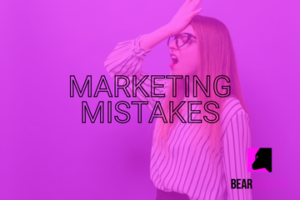Content marketing mistakes could be holding back your results, but they are relatively easy to fix.
We passionately believe that content marketing is the single most effective way to educate prospective clients, build trust, and pre-saude people to do business with you.
But what happens when your content isn’t achieving the desired results?
If you’re working hard to write blogs, publish podcasts, and record videos, seeing little to no results can be disheartening.
You’ve been consistently publishing your content for months, but zilch, nada, not a bean in return.
It’s enough to make anyone want to throw in the towel.
In our experience with content marketing, there are a few mistakes you could be making. Thankfully, once identified, these mistakes are simple to fix, taking your content from zero to hero.
Target audience
The first mistake is failing to address a specific audience.
I’ve made this mistake in the past. I quickly discovered there is a direct correlation between the content you publish and the prospects who get in touch.
When I wrote blogs about managing debt, it generated enquiries about managing debt. At the time, my goal was to create enquiries about investing money and taking pension income, not paying off credit cards or dealing with pesky creditors.
Addressing your specific audience means having a clear picture of your ideal client. We call this clear picture a client or customer avatar.
It also helps to know their significant concerns.
Knowing your client avatar and the issues that keep them awake at night allows you to focus your content on the right people; you speak to their concerns and solve these with your content, and your tone of voice is appropriate for your client avatar.
Consistency counts
The second mistake is a lack of consistency.
It took me nearly 20 years to become an overnight success with my content marketing.
Yes, you can get the occasional fast response from an exceptionally well written and engaging piece of content, but it’s more likely that it will take years to build your audience, and to become known, liked and trusted for what you do.
All too often, I see business owners who give something a go for a few months and then promptly give up because the results aren’t immediately apparent.
It would be best if you were patient for this stuff to work. And during that period of patience, you need to be consistent.
If your message constantly changes, how can you become known for what it is you do?
Consistency doesn’t mean that your message needs to be identical in each piece of content you create; vary the message, but remain consistent with the core values behind each message.
Purple cow
 The third mistake is not being willing to stand out from the crowd.
The third mistake is not being willing to stand out from the crowd.
We all operate in an increasingly noisy market. As time goes by, there’s an ever-growing choice of content to consume.
Our time and attention remain finite while the content available to consume grows exponentially.
Three hundred hours of new videos are uploaded to YouTube every minute. You can’t compete with this by producing a higher volume of content (although you should probably be posting more each week than you do now – a topic for another post!), but you can compete by standing out from the crowd.
Seth Godin refers to this as the Purple Cow approach.
When you drive past a field of black and white cows, it’s nothing remarkable, but when you spot a Purple Cow, now that’s worth shouting about.
So create remarkable content that gets people talking for all of the right reasons.
Poor promotion
The fourth mistake is failing to promote the content you create.
Don’t publish a blog, and then expect your target audience to find it all by themselves!
For each bit of content you create, you need a promotion strategy, which covers multiple channels and attempts to reach as many people in your target audience as possible.
Don’t publish, and then hope for the best! A well-crafted blog will be found organically via search engines, but never rely on this semi-accidental discovery. Publish your content and then shout about it!
Prejudicial avoidance
The fifth mistake is limiting yourself to a handful of established platforms because of commonly held misconceptions.
For example, you might not use Facebook because your clients aren’t active there. Or you might not use LinkedIn because it’s full of spam from recruiters.
You allow your prejudices about various platforms to stop you from using them and reaching your target audience, who do hang out on Facebook, and who do still use LinkedIn, despite the recruitment spam.
So that’s five common mistakes we see when it comes to content marketing; mistakes that you need to stop making or they will dampen your results and leave you feeling disheartened.
5 common content marketing mistakes you need to know (and fix!) to get better results today Share on X


